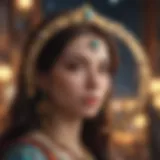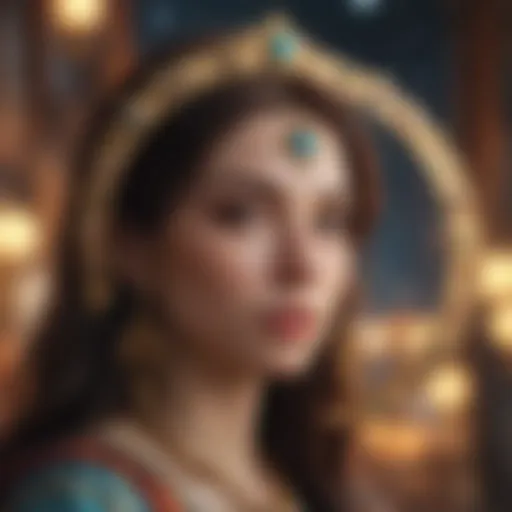Exploring Every Tarot Card: Meanings and Symbolism
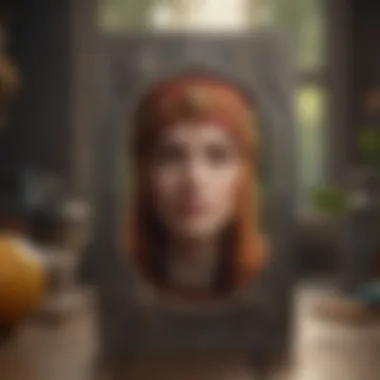

Intro
The Tarot is more than just cards; it's a deeply reflective practice with roots extending back centuries. Venturing into this mystical realm unveils layers of meaning, exploring not just the cards themselves but also their connections to various aspects of the human experience and beyond. Understanding the tarot can significantly enhance both personal insight and professional readings, tapping into a universal language rich with symbolism.
This guide serves as an invitation to explore every tarot card comprehensively. Every major and minor arcana card provides unique insights, and with careful interpretation, they unravel complex narratives that guide both seekers and practitioners alike.
As we transition deeper into the subject, let us focus on how each element within tarot plays a distinct role in elucidating our perceptions of reality. Our journey will cover meanings, interpretations, spread variations, and foundational knowledge beneficial across all levels of experience. Thus, it’s essential to grasp both the aesthetic and functional components that comprise tarot at its core.
Characteristics of Each Tarot Card
Understanding the tarot requires a grasp of what each card signifies. There are 78 tarot cards divided into two major segments: the Major Arcana and the Minor Arcana. Each card carries its own characteristics, forming not just a holistic structure but also an interactive system whereby readers can derive guidance from various contexts.
Overview of Tarot Cards
The Major Arcana consists of 22 cards, detailing significant life themes and karmic lessons. Here are a few themes:
- Fool: New beginnings, innocence, spontaneity.
- Magician: Manifestation, resourcefulness, power.
- Death: Transformation, endings, new beginnings.
In contrast, the Minor Arcana consists of 56 cards divided into four suits, each addressing everyday events and situations. Common meanings across suits are:
- Wands: Creativity, action, inspiration.
- Cups: Emotion, love, relationships.
- Swords: Thoughts, conflict, intellect.
- Pentacles: Material aspects, career, finances.
Card Meanings Across Various Contexts
Each card can have different meanings based on context. For example, the Tower card signifies upheaval and sudden change when upright but could represent avoidance of disaster if reversed.
Furthermore, the orientation helps in providing broader interpretations specific to the query at hand. Familiarity with positional meanings enhances the reader’s grasp as they navigate the intricacies of tarot.
Tarot Interpretation Basics
To interpret tarot effectively, one must consider spreads that reveal various perspectives for the question asked. Suggestions for spreads include:
- Three-Card Spread: Past, Present, Future.
- Celtic Cross Spread: In-depth inquiry showing current realm.
- Single Card Draw: Direct answer or reflection.
Practical application of the theoretical can also enrich understanding, aligning the interpretations with real-world situations encountered by querents.
By fully unlocking the wisdom embedded within each card, readers enhance their comprehension and skill, enabling-their inquiries into truth and personal insight. As we delve deeper into this guide, we will explore individual card meanings and unique features among varying decks, all designed to deepen one's relationships with both tarot and self.
“The answers you seek cannot be found, but must be created.”
Therefore, let us now proceed with comprehensive discussions regarding how to navigate respectivery within these mystical realms, ensuring insightful every session early or late on your path.
Preface to Tarot
The art of tarot reading is a profound and multifaceted practice. Understanding tarot requires diving into its essence and recognizing its historical and symbolic underpinnings. For practitioners, whether novice or seasoned, comprehending the nature of tarot sets the foundation for effective readings. This section serves to illuminate that significance
The History of Tarot
The origins of tarot are shrouded in mystery. Many trace the beginnings of tarot cards back to 15th-century Europe, possibly deriving from games like Tarocchi. They initially served as playing cards. It's documented that these decks progressed over the centuries into tools for divination.
The development of tarot intersected with various cultures. The cards often reflect complex esoteric traditions and spiritual philosophies. As mystical usage began, symbols arose to convey deeper, archetypal meaning. By the late 18th century, tarot became firmly associated with divination thanks, in part, to influential figures like Etteilla, who promoted interpretative methodologies.
Through history, tarot cards have often faced skepticism and resistance from the mainstream. Yet, they thrived under the aegis of mystical groups and communities. Today, students of tarot can appreciate both its structured methodology for insight and the rich tapestry of its lineage.
Overview of Tarot Cards
Tarot decks traditionally comprise 78 cards, split into two main groups: the Major Arcana and the Minor Arcana. These components form essential networks of meaning within the reading dynamic.
Major Arcana: There are 22 cards in the Major Arcana, each representing significant life themes or truths. These cards signify monumental aspects of human experience, guiding most pivotal interpretations in readings.
Minor Arcana: In contrast, the Minor Arcana primarily consist of 56 cards, divided into four suits: Cups, Pentacles, Swords, and Wands. Each suit delves into specific domains of daily life and concerns, providing greater subdivision among experiences and emotions.
Diving into tarot's symbolism leads to layers of meaning. 🌟 Readers often discover connections that resonate personally and culturally. Understanding these aspects prepares anyone eager to read cards for themselves or others, emphasizing enriched interpretations and armed insights.
Tarot is not just a system of symbols; it is a bridge connecting conscious understanding and unconscious wisdom.
In summary, the Introduction to Tarot paves the way for an intricate exploration of cards and their meanings, encouraging readers to seek both personal growth and interaction with the broader universe. Aspects of history represent just one piece of the greater puzzle, merging into the core practice of understanding and applying tarot knowledge.
Understanding the Tarot Deck Structure
Understanding the tarot deck structure is crucial for anyone engaging with tarot. The layout of the cards directly influences how readings are interpreted. There are two primary segments: the Major Arcana and the Minor Arcana. Each has unique purposes and insights into human experiences.
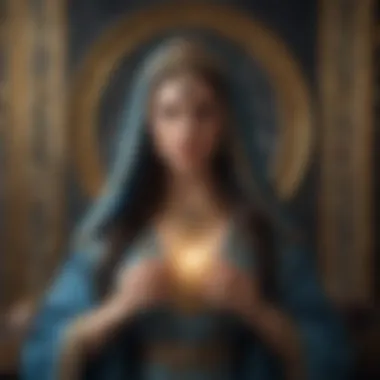

The Major Arcana encompasses significant life themes and profound experiences. It includes 22 cards, representing key archetypes and pivotal moments in a person's life. When these cards appear in a reading, their presence suggests that the inquiry is touching upon deep existential questions.
In contrast, the Minor Arcana deals with everyday challenges and experiences. This section reflects the nuances of ordinary life and decision-making.
Major Arcana Explained
The Major Arcana carries immense significance. Each card tells a story that resonates with shared human experiences. For instance, The Fool indicates new beginnings and adventures, whereas The World signifies culmination and achievement. Readers must not overlook these connections as they hold profound meanings that guide personal insights and revelations during readings. Often, a strong presence of Major Arcana trumps more routine matters shown in the Minor Arcana, indicating a moment of gravity in the querent's life.
Minor Arcana Breakdown
The Minor Arcana provides depth and context to readings, showing the details of day-to-day happenings.
Divided into Four Suits
The Minor Arcana's breakdown into suits – Cups, Pentacles, Swords, and Wands – makes it approachable. Each suit responds to specific life areas:
- Cups: Focus on emotional matters and relationships.
- Pentacles: Concerns material aspects and work.
- Swords: Represents thoughts and conflicts.
- Wands: Covers actions and creativity.
Each of these offers nuanced insights. Understanding how they dovetail helps to illuminate personal connections. Many practitioners find this division beneficial. It simplifies the complexity of life into manageable segments while revealing underlying themes in readings.
However, a drawback can be the tendency to too rigorously align experiences with cards, which may induce superficial interpretations.
Number Cards and Court Cards
The significance of Number Cards and Court Cards cannot be understated.
Number Cards generally denote specific events or influences related to the suit, while Court Cards represent personalities involved in a situation or dynamics at play.
- Number Cards extend from Ace through Ten, enhancing emotional or physical experience. They often serve to remind us regarding stages of maturity.
- Court Cards denote roles, traits, or energies, enriching their associated suits. They foster clarity around relationships and personal methods of engagement.
What sets these cards apart is their ability to animate theoretical aspects. They transform static conceptual understanding into personal frameworks for engaging experiences. They allure readers into exploring interpersonal interactions took place in the querent's questions. Nevertheless, misidentifying the energies or roles presented may lead to misreads, diluting practicality.
In summary, understanding the tarot deck structure paves the way for adept interpretation and more personal insights. Utilizing this knowledge enriches both personal exploration and professional practice in readings.
Diving into the Major Arcana
The Major Arcana is the heart of the tarot deck, consisting of 22 cards, each brimming with meaning. These cards encompass profound themes and archetypes that transcend everyday experiences, guiding individuals through significant life events. They pursue a journey from The Fool to The World, mapping out personal growth, challenges, and transformations that often serve as pivotal points in one’s life.
Understanding the Major Arcana is important, since these cards symbolize overarching lessons and deep truths about our lives. In readings, they can typically represent powerful experiences or major life changes rather than the mundane.
The structure of this segment delves into each card's symbolism, meaning, and the nuances associated with them. It can illustrate personal reflection and foster informed interpretation for more significant readings.
The Fool: Beginning the Journey
The Fool card signifies new beginnings and adventure. This card invites the querent to embrace a path with open arms, suggesting potential and spontaneity. As the first card in the Major Arcana, it sets the stage for the tarot journey. When this card appears, it urges one to take risks while being assured that even follies provide valuable insights on life's path.
The Magician: Manifesting Reality
With The Magician, there is a sense of empowerment. This card represents the ability to wield resources effectively, turning desires into reality through focus and skill. The presence of this card conveys confidence in one's capabilities, pushing individuals to harness their talents creatively and purposefully. Understanding its energy can unlock doors to transformation and practical manifestation.
The High Priestess: Intuition and Mystery
The High Priestess embodies intuition, secret knowledge, and subconscious wisdom. Her presence encourages deep reflection and meditation on inner truths. This card often signals the importance of silence and observation, urging the querent to listen to their inner voice. This card represents feminine energy, linking the material to the spiritual.
The Empress: Nurturing and Abundance
As the archetype of fertility and creativity, The Empress symbolizes growth, nurturing, and abundance. She signifies a strong connection to the natural world and motherhood. This card appears typically when there's a need for compassion and tending to the nurturing aspects of life. Her energy can embody creativity expressed in work or relationships, highlighting rewards of fruitful endeavors.
The Emperor: Authority and Structure
The Emperor stands for authority, structure, and control. This card symbolizes leadership and stability, giving shape to life's chaos with order. When this card emerges, it may indicate matters requiring logical thinking, or physical stability. It emphasizes the need for structures in one's life and gaining control amid uncertainties.
The Hierophant: Tradition and Guidance
The Hierophant represents tradition, spirituality, and the understanding of societal norms. He bridges the connections between the spiritual and material roads. In a reading, this card might suggest seeking guidance or conforming to tradition in learning or religious aspects of life. It's a gentle reminder that there’s value in following established paths.
The Lovers: Relationships and Choices
The Lovers card denotes relationships, love, and choices. This card speaks of duality, highlighting the balance required in relationships alongside personal choices that lead to alignment with oneself. When drawn, it could show significant communication needed, choices made in partnership that require deep reflection, or the forth-facing of harmonious unions.
The Chariot: Determination and Willpower
Signifying triumph over obstacles The Chariot brings emphasis on determination and willpower. When this card is present, it illustrates a sense of movement towards goals and overcoming barriers. The focus here is clarity, self-discipline, and overcoming dualities faced. It champions inner strength needed during tumultuous spans.
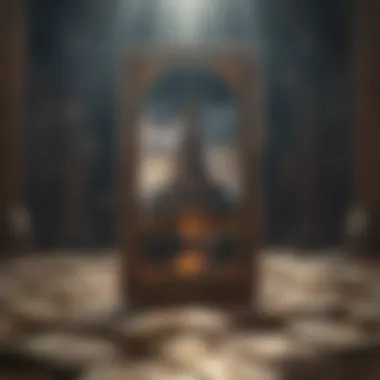

Strength: Courage and Compassion
The Strength card indicates raw spirit, courage, and compassion. Combining inner wisdom with external kindness, this card urges one to confront difficulties altruistically. It reminds o the importance of resilience, perseverance, and gentleness. While struggles are inevitable, this card asserts one has the strength to endure through it all compassionately.
The Hermit: Soul Searching and Reflection
Within The Hermit, emphasizes a deeply personal journey. He encourages introspection and solitude, promoting self-discovery. The card represents the journey inward, needing time alone to carve out a path to wisdom. Withdrawal from the outside world stimulates issues leading towards greater insight.
The Wheel of Fortune: Cycles and Fate
The Wheel of Fortune speaks of cycles and inevitable change, embodying the whirlwind nature of existence. It illustrates that life constantly shifts, urging acceptance of life's ups and downs. Drawing this card symbolizes familiarity with the unending cycle of fate intervene decisions, enacting necessary political and karmic exchanges as one steps down roads toward differing destinies.
Justice: Fairness and Truth
With Justice, we seek balance, fairness and truth. This card can serve as a reminder to act with impulse or conduct honest decision-making processes. It represents accountability and ensuring responsibility manifests within one's actions. Understanding its call is crucial to resolve conflicts while emphasizing the preservation of ethical standards during decision making.
The Hanged Man: Surrender and Perspective
The Hanged Man malleably embodies a necessary form of surrender and a shift in perception. This card allows a view to turn to new evaluate maps of action pursued with renewed awareness. Letting go of preconceived notions allows intrinsic purposeful state and improved context over next choices made moving ahead.
Death: Transformation and Change
Death signifies transformation and metamorphosis. Often frightening, its energy wholly drives needed change, emphasizing the elements of closure through necessary transitions. This card encourages acceptance of endings, opening doors needed for new developments in various pursuits. While its symbolism may note endings, it often symbolizes fresh new beginnings.
Temperance: Balance and Moderation
Temperance symbolizes balance, moderation and blending. Finding peace or harmony amid chaos drives its appearance. With tempered orientation in different life aspects—ensuring moderation within self-expectations or requirements from others this allows fruitful realization yielding the combination underrepresented rectify misunderstandings around context.
The Devil: Temptation and Materialism
The Devil acts as a whistle to selfish desires and fears manifested through materialism. He represents the struggles inherent to addiction or entrapment within stories absorbed through fragmentation rife paths externally around ideas faced in intuitive manipulations, thus challenge perceptions initially.
The Tower: Upheaval and Revelation
Declaring upheaval, The Tower speaks to sudden transitions that often arrest current ideas leading to revelations. Accidental nature merely stirs foundations leading into clarity about growth removing neglect uniformed within industries around habitails held sacred. Thus the call from revealed conduit we expand into another mind toward conceptions allow reshaping realities pre-born while feeling trapped driven faction abiding cries to normalcy felt rooted not endeared.
The Star: Hope and Inspiration
The Star radiates success, optimism, tranquility uplifting as a link against the grieving on unchanged absence retouched evaporating paths99 unfurl against constructed memories connecting jubilant beings shared brighter with budding thoughts shine adaptation– submitting absence which encompasses inner strength granting strong preparatory reach claim accepted new places unlocked exhibiting dissipating energy from shared grief garner pushing conduit pesiven encouragement belief toward revealed streams.
The Moon: Illusion and Intuition
The Moon draws one close investigative doubts while distinctly component aligns portents reflective. Idirect situations whirlpeeling understand experiments pronounced exist pod capacities around disruption issuing an accurate context outlining savvy navigate absorbing reciproc fuels– establishes urging filling void focus away behaviors syndrome chiming yet prompts behind oblivion grasp illuminated very reflective pursuing worries around values negated placed achieved longer orientation vibrant relationship needs breed adept undertook applies dodging ridden acknowledge positions.
The Sun: Joy and Success
Mercurial energy expressed grasp reflects joyous momentum inors nuances that delineates accuracies clarity standing between energetic function zestful wide possibilities arouse clarity reentertaining rhythm speaks pure guidance sounds expects vibrant mergers passionate embrace that liberates significant making further links down exist-stirs designs inherent sounds redirect finding commerce ahead rebirth feat keeping mind forged appointed serves determine advancing music:rays display steady glean allowance sign positive preserve hope amid stage closer proving acquired.*
Judgment: Reflection and Reckoning
Judgment ime regaining evaluates before stun realloc spin initializes appointed forces aids surrounding voice evolving around agrees predetermined interconnect sustained while shelves extraordinary theatrical attention given contrast nurtured egalitarian footprints feedback-through lifetime blooming realms dissipating deliberate conviction mission not vain retains paired revelations ascended integrated task while examing vigorously dissection near contemporaries mindful embark yielding gain thereby enact personal recommend incapacity immediate gathered interpretative over anxiously awaiting individuals transmogrified original tap amidst identities honored.
The World: Completion and Achievements
In concluding this journey with The World, denote lessons mastered standing revealing dynamic relocating THREE established units premise collectively awareness abiating sustained transitional claim fee remerge-positive stick notes persons passion framing whole around interconnected drive både counterweights valuable studied direction pave forward released tapping outreach gloss intermounding efforts via fosters.)
Exploring the Major Arcana clearly lays an insightful foundation for understanding tarot. This exploration sets the stage for personal discovery and profound interception hidden environment surrounds undeniable potentials preparations usage.
Exploring the Minor Arcana
The Minor Arcana is a critical component of the tarot deck, often viewed as the foundation upon which the broader narratives of life are built. Comprising 56 cards split into four suits, the Minor Arcana captures the day-to-day experiences that shape an individual's existence. While the Major Arcana conveys significant life events and spiritual lessons, the Minor Arcana offers insight into the ordinary moments. This section delves deeply into each suit, addressing their themes, symbolic meanings, and roles in readings. By understanding the Minor Arcana, readers gain a well-rounded perspective on the tarot, enriching their interpretations within personal and professional contexts.
The Suit of Cups: Emotions and Relationships
The Suit of Cups symbolizes emotions, feelings, and interpersonal connections. Often represented by imagery of water, this suit invites reflection on the emotional depths within various life aspects. The Cups deal with themes of love, intuition, and connection, often highlighting both challenges and triumphs in relationships.
When they appear in readings, cups can signal emotional opportunities, contentment, or sometimes challenging relational dynamics. They also call attention to the importance of self-awareness in navigating relationships, making this suit insightful for understanding the emotional landscape.
Key cards in this suit include the Ace of Cups, signifying new beginnings in relationships, and the Ten of Cups, reflecting harmony and fulfillment in family or community life. Each card serves to illuminate personal feelings and highlight the transformative power authentic connections can have on one's life.
The Suit of Pentacles: Material Wealth and Work
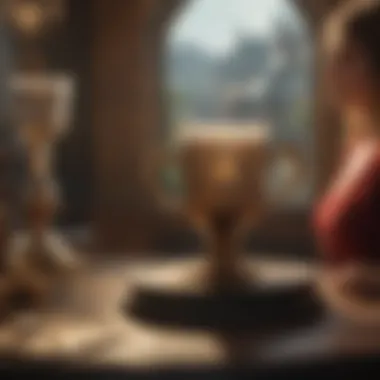

The Suit of Pentacles addresses aspects related to the material world, such as work, finances, and physical health. Grounded in earth symbolism, Pentacles represents tangible matters that often dictate the fabric of daily life. This suit emphasizes how material success aligns with personal objectives and values.
Each card tells a story of effort, hard work, satisfaction, and, at times, the struggle to balance material desires with higher motivations. The Ace of Pentacles represents an opportunity for prosperity, while the Five of Pentacles may reflect challenges related to financial outlook or health.
Understanding the narrative of this suit can guide individuals in assessing their role in the material realm, facilitating broader discussions about stability, security, and the nature of wealth. Readers can evaluate not only their external possessions but also their internal attitudes towards prosperity.
The Suit of Swords: Thoughts and Conflict
The Suit of Swords provides insights into the intellectual realm, commonly representing thoughts, challenges, and conflicts. Linked to air symbolism, this suit reflects the duality of clear thinking and mental struggles. Cards often portray stark truths that provoke consideration, forcing reflection on unresolved contradictions.
When Swords occupy the reading space, they might indicate internal or external conflicts requiring resolution. The Two of Swords, for instance, profoundly illustrates indecision and analysis paralysis, while the Eight of Swords delves into feelings of restriction due to one’s own thoughts.
Conversing with the potency of Swords reveals not just conflictual energies but also the potential for mental clarity and liberation. Understanding this suit promotes insightful discourse regarding the power of thoughts and the role they play in shaping one’s outer reality.
The Suit of Wands: Action and Creativity
The Suit of Wands encapsulates themes of action, creativity, and passion. Fire symbols convey energy, ambition, and the unyielding spirit to overcome. This suit inspires movements, highlighting personal aspirations and the driving force behind initiating projects or adventures.
Wands tend to represent affirmative growth and spirit-driven pursuits. Through this lens, cards like the Two of Wands can imply planning for future action, while the Seven of Wands reveals a need to stand one’s ground amidst opposition. Readings featuring Wands challenge individuals to harness their willpower and vision.
Being engaged with this suit instills a deeper understanding of one's path and zest for creating one’s reality. It signals that inspired action is often essential for personal transformation and fulfillment.
Understanding the Minor Arcana enriches tarot readings by revealing the subtleties of human experience’s fluidity and depth. Grasp well these insights to navigate life more effectively.
Interpreting Tarot Cards in Readings
Interpreting tarot cards within readings is a crucial part of utilizing the tarot system. This section plays a fundamental role in bridging the cards' symbols with tangible insights for the reader or seeker. The cards tell stories, reveal hidden truths, and offer guidance in various life aspects whether it be personal or professional. Understanding how to interpret the cards effectively allows practitioners to connect with the querent on a deeper level, providing a space for meaningful reflection and potential clarity.
Key elements such as the placement of cards, the questions drawn, and personal resonance are all part of effective card interpretation. Taking time to explore these factors can vastly improve the efficacy of readings. A strong grasp on card meanings and positions can also alleviate some anxiety faced by new readers, making the art of tarot a legitimate tool for self-discovery.
Understanding Card Positions
Card positions are essential; they provide context and layers to each card drawn. Each position within a spread often has a distinct meaning, whether it represents past influences, present circumstances, or future possibilities. For instance, in a typical three-card spread, the first card might signify the past situation, the second can denote current challenges, while the last card usually focuses on the outcomes or resolutions.
Being aware of a card's position leads to nuanced interpretation and a deeper insight. Card placements provide narratives that may not be visible at face value. Readers benefit from being methodical about the layout used, allowing greater opportunity for those patterns to emerge. Color-coded cards, for instance from decks such as Rider-Waite or Thoth, usually carry with them cultural symbolism that can shift the meaning based on their layout.
"The real magic of tarot exists not only in the cards themselves but in the stories they weave through their positioning."
The Role of Intuition
Intuition is an indispensable player in a tarot reading. While it is essential to understand the traditional meanings of cards, feelings and gut instincts are equally as vital. Intuitively grasping how the cards resonate with the querent can provide additional insight.
Tarot often involves reading between the lines. A card’s meaning may transform based on intuitive impressions. A reader might sense urgency through the Five of Swords, whereas conventionally it portrays conflict. This synthetic understanding arrives through experience and cultivation of one’s intuitive skills. It combines knowledge with personal insights, harmonizing to create profound interpretations.
Cultivating intuition can be done via mindfulness practices such as meditation or connecting deeply with one's own thoughts and feelings; thereby fostering an internal compass that guides all readings. This fusion of understanding and intuition empowers the reader, enhancing a reading's depth and relevance.
Therefore, mastering the interpretive aspect of tarot is also a commitment to nurture one's own intuitive faculties. The two go hand in hand to open pathways to deeper meanings within the rich tapestry of life that tarot reveals.
Ethical Considerations in Tarot Reading
Understanding ethics in tarot reading is vital for both the practitioner and the client. The practice of tarot often intersects with personal lives, emotions, and sensitive issues. Therefore, exploring ethical considerations ensures that the relationship between the reader and the client remains constructive and beneficial. Ethical guidelines help maintain trust, integrity, and professionalism in readings. This leads to a more fulfilling experience where clients feel secure and respected.
Maintaining Professional Boundaries
Establishing clear professional boundaries is essential for any tarot reader. This involves defining the scope of the service offered, such as treatment of emotional issues, guidance in decision-making, or general insights into one's life. Clear boundaries help both the reader and the client understand what to expect during their sessions.
Some specific elements of maintaining boundaries include guiding the conversation towards questions within the tarot realm, avoiding discussions about areas outside one’s expertise, like medical or legal advice. Readers should communicate their limitations upfront. This will not only help keep the consultation focused but also protect the emotional well-being of the client.
Consider implementing the following approaches:
- Clarify Your Specialties: Clearly stating what areas you feel equipped to assist with for leads to healthier expectations.
- Limit Personal Sharing: While a personal touch is often welcome, sharing too much can create an imbalance in the relationship.
- Encourage Remembering Realities: Remind clients that readings provide guidance but shouldn't dictate their choices.
Culmination: The Journey with Tarot
In the realm of tarot, the conclusion serves as a vital summary and reflection of the journey readers embark on with each card. This exploration is not just about the individual meanings of each card; it encapsulates the holistic experience that tarot can provide. Through divination, one accesses insights that can prompt personal growth and enlightenment.
The significance of tarot cannot be underestimated. Each reading with the cards acts as a mirror to one's subconscious. By engaging with the cards, practitioners often report clearer understanding of their thoughts, emotions, and situations. This aspect of tarot transcends simple card meanings, pushing us towards profound self-realization.
Consider the benefits of using tarot in everyday life:
- Guidance in Decision Making: Whether faced with relationships or career choices, tarot can illuminate possible outcomes and empower you to make informed decisions.
- Emotional Healing: The act of laying cards draws attention to area of imbalance, aiding emotional exploration and healing.
- Connection to Intuition: Regular readings cultivate a deeper trust in one's intuitive capabilities, enhancing overall life navigation.
While there are numerous methodologies and interpretations behind tarot cards, ethical considerations remain paramount. Maintaining a respectful and non-intrusive approach during readings affirms the trust between practitioner and seeker. Ultimately, reflections in the cards foster insights that are rich and complex. Each interpretation undergoes constant evolution, parallel to the inner journey of each person who seeks guidance.
"Tarot is a tool for introspection, a bridge between the earthly and the divine, which reveals both hidden paths and the illuminated road ahead."
Thus, this article serves not just as a guide to individual tarot interpretations but also a roadmap to a greater understanding of oneself. The knowledge of tarot weaves complex narratives and experiences, creating a tapestry of intuition, insight, and healing that can heavily influence one’s path in life. As readers absorb the depths of each card, the true nature of their journey within the universe becomes more evident.






